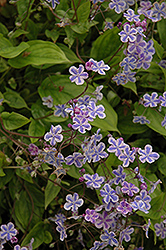Plant Height: 6 inches
Flower Height: 8 inches
Spacing: 10 inches
Sunlight:
![]()
![]()
Hardiness Zone: 6b
Other Names: Navelseed, Blue Eyed Mary
Description:
Clusters of starry flowers with white edges and bright blue center stripes appear above low mounds of green foliage in spring; prefers cool shady areas, perfect for a woodland garden; also excellent for containers
Ornamental Features
Starry Eyes Navelwort features showy racemes of white star-shaped flowers with shell pink overtones and sky blue stripes rising above the foliage in late spring, which emerge from distinctive violet flower buds. Its attractive oval leaves emerge chartreuse in spring, turning dark green in colour throughout the season.
Landscape Attributes
Starry Eyes Navelwort is an herbaceous perennial with a ground-hugging habit of growth. Its medium texture blends into the garden, but can always be balanced by a couple of finer or coarser plants for an effective composition.
This plant will require occasional maintenance and upkeep, and is best cleaned up in early spring before it resumes active growth for the season. It is a good choice for attracting bees and butterflies to your yard. It has no significant negative characteristics.
Starry Eyes Navelwort is recommended for the following landscape applications;
- Mass Planting
- General Garden Use
- Groundcover
- Naturalizing And Woodland Gardens
Planting & Growing
Starry Eyes Navelwort will grow to be only 6 inches tall at maturity extending to 8 inches tall with the flowers, with a spread of 12 inches. When grown in masses or used as a bedding plant, individual plants should be spaced approximately 10 inches apart. Its foliage tends to remain low and dense right to the ground. It grows at a medium rate, and under ideal conditions can be expected to live for approximately 10 years. As an herbaceous perennial, this plant will usually die back to the crown each winter, and will regrow from the base each spring. Be careful not to disturb the crown in late winter when it may not be readily seen!
This plant does best in partial shade to shade. It does best in average to evenly moist conditions, but will not tolerate standing water. It is not particular as to soil type or pH. It is somewhat tolerant of urban pollution. This is a selection of a native North American species. It can be propagated by division; however, as a cultivated variety, be aware that it may be subject to certain restrictions or prohibitions on propagation.
Disclaimer - This resource is provided for informational purposes only and does NOT reflect current availability. Inventory varies seasonally, so we cannot guarantee that every plant will be in stock at all times - please contact your favourite GardenWorks location directly for current availability. It does not include our entire inventory of plants, so be sure to visit GardenWorks to see varieties that may not be represented on this list.

